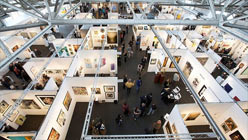
San Francisco Fine Art Fair at Fort Mason
The SFFAF filled the vast Festival Pavillion at Fort Mason and even if you were new to the art fair world, this fair had a dry and expected feel, almost as if an art shopping mall was dropped on-site, already assembled. The Galleries were formal and extremely professional with Oakland-based Chandra Cerrito Contemporary, San Francisco’s Cain Schulte and Smith Anderson North in San Anselmo as the stand out Bay Area Galleries. The Performance Art Institute, which presented the student exhibition, Cream, was given a generous space in the back of the fair for these emerging artists to show off their work. The work in this group was remarkable and energetic, but with few emerging artist or experimental galleries with booths in the fair, there was a disconnect between the formality of the layout to the work of these young artists.
Overall, the SFFAF represented an important part of the art market in that it catered to a specific (more traditional?) collector who was interested in buying art made by or created in the spirit of more established Modern and contemporary artists than buying out of impulse or the thrill of buying the next new hot artist.

ArtMRKT at the San Francisco Concourse, Photo: Drew Altizer
ArtMRKT by and large was more serene and easier to access. There were far more recognizable contemporary galleries and generally a smoother cohesion of work from booth to booth. The layout, the better access to food and drinks and seating areas and the quiet acoustics made ArtMRKT more manageable to consume. It might seem strange to prefer one market over another because of these seemingly inane reasons, but they make a difference when spending hours walking and looking. The galleries selected also presented strong work with an effective balance between famous artists and the up and coming talents. The work in general felt current, contemporary and intriguing.
One of the market’s curators, Catharine Clark had her gallery’s booth right up front with Paule Anglim Gallery right next to it, both spaces showing their always remarkably engaging stable of artists. Other local standouts were; Fouladi Projects, Geoffrey Chadsey’s stunning work at Electric Works, Paul Wacker’s paintings at Eleanor Harwood Gallery were incredible within an already extremely strong San Francisco gallery presence. Other galleries at ArtMRKT worth visiting in person or online: Brooklyn-based Like the Spice Gallery; Charlie James Gallery from Los Angeles; and the non-profit Black & White Project Space, which was selling lusciously printed beach towels with a Chanel perfume bottle in black and white as some sort of ironic twist on fundraising.
Black & White Gallery was not the only one with fundraising in mind. ArtMRKT hosted a silent auction (MRKTworks) during the fair to support Bay Area arts organizations; ArtPractical, Southern Exposure, Creativity Explored and Headlands Center for the Arts were all beneficiaries of this understated but effective silent auction. (The auction raised $7500 for the organizations mentioned above, in addition to $10,000 raised on opening night for the Art Program at the new UCSF Mission Bay campus.) Considering the deep local talent on display, the support of local organizations through MRKTworks and the addition of local arts installations right at the main entrance, ArtMRKT came off as a well-organized, pleasant and deeply rich exhibition of the San Francisco art world.

ArtPadSF at The Phoenix Hotel, Photo: Stephanie Versin
And then there was ArtPad. Inside the so hip it hurts Phoenix Hotel, there were 30 galleries in hotel rooms facing an outdoor courtyard, hosting what felt like a super cool and boozy opening reception that never ended. By far the most accessible and approachable fair, visitors could meander in and out of hotel rooms and see a variety of contemporary work from San Francisco and Oakland, with a few LA Galleries thrown in for good measure. For the local, avid arts viewer, there were few surprises at ArtPad. The artists and galleries were familiar, but that is not to say it wasn’t fun to wander through the hotel to find some sweet gems in these beloved San Francisco galleries.
Lisa Blatt’s performative and conceptual pieces at Steven Wolfe Fine Arts were some of the more exciting pieces at ArtPad along with Weston Teruya’s intricate drawing and sculpture at Patricia Sweetow Gallery and it certainly didn’t hurt that Michael Rosenthal Gallery had Chris Eckert’s ball point pen tattoo machine that would randomly inscribe a religious tattoo on your arm for free.

ArtPadSF by the pool at The Phoenix Hotel, Photo: Stephanie Versin
Over the weekend, ArtPad gallerists openly commented that sales were slow and smaller items were going faster than higher ticket items. For the smaller galleries, these sales were a cause for great celebration and for the older, more-established galleries, the fair represented a chance to reconnect or meet a newer, younger group of collectors.
No matter the overall sales figures, all three of these fairs fight half the battle for the gallerists by providing them with an already engaged audience. The people who came to the fairs were interested in looking at work and were either ready to buy or ready to learn about how to buy. This simply isn’t the case in a typical gallery setting, where visitors are more likely to be tourists or passive viewers than serious collectors. That is not to say that the gallery owners were expecting to sell out their booths this year at any of the fairs. As was the case with ArtPad, the impression was that these fairs were an investment in the future of a higher level of collecting culture in San Francisco. Gallerists aimed to deepen their mailing lists, meet new collectors and associate themselves with the tone of whichever fair they were representing.







